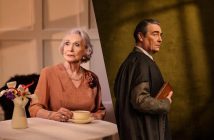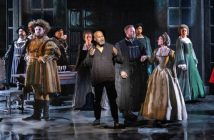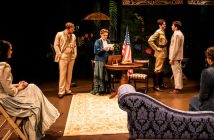The Woman in Black, a play based on Susan Hill’s spine-tingling 1983 novella, is the second longest running play in the West End (the first being The Mousetrap) and, 27 years on, is still terrorising theatre-goers, whilst having enjoyed a boost of interest following the release of the 2012 film version starring Daniel Radcliffe. Unlike the medium of film, which inevitably leans on special effects and sound, the beauty of the play is the imagination that audiences are required to bring with them, and which therefore makes for a much more rewarding experience.
A young solicitor by the name of Arthur Kipps is tasked with travelling to the small English town of Crythin Gifford in order to handle the affairs of his late client Mrs Alice Drablow, yet in the play we first meet Kipps (David Acton) thirty years on as he approaches a young actor/director (Matthew Spencer) about having his story turned into a play.

In truth, we learn very little in the first half an hour other than that Kipps isn’t cut out to be an actor, yet feels passionately about having his tale told and is convinced that it can lift the curse which has stayed with him and his family ever since his fateful journey to Crythin Gifford, yet from the point when the actor adopts the role of the young Kipps things begin to get chillingly intriguing, with the bulk of the play being a flashback of his ghostly encounter at the late Mrs Drablow’s isolated home, Eel Marsh House.
Located on Eel Marsh Island, the house can only be reached by travelling the Nine Lives Causeway which floods in high tide, blocking all access; cue Acton in a variety of roles including the stony-faced driver. The anticipation of seeing ‘The Woman in Black’ herself is very great, and we urge Kipps on to uncover the mystery of the countless infant deaths in the village, the preserved nursery at Eel Marsh House and the empty rocking chair, undoubtedly the creepiest image of all.

The play’s longevity is due to both Robin Herford’s masterly direction and the late Stephen Mallatratt’s suspenseful adaptation, which relies on a two-man tour de force to reveal the tale gradually, by sharing roles and utilising a series of props. How easily, with a little imagination, a wicker basket is transformed into a desk, an altar, a bed or a pony and trap! First performed at the Stephen Joseph Theatre in Scarborough (home of Alan Ayckbourn) in 1987 of which Herford was Artistic Director, the two-man structure mirrors the creative partnership between Herford and Mallatratt, neither of whom ever imagined that their production was destined to be seen by nigh-on seven million theatre-goers.
The play has slowly rather than radically evolved over the past twenty seven years it has been running at London’s Fortune Theatre, yet by the very nature of changing a cast every nine months, each performance has a unique feel, something which contributes to the high level of return visits. This touring production, which I caught up with at the Theatre Royal Bath – a venue especially suited to an atmospheric tale of this kind – features proficient performances by David Acton and Matthew Spencer, and there were screams aplenty from younger members of the audiences experiencing it for the first time. Although it wasn’t my first time I did find myself jumping out of my skin on occasion, nor do I expect it to be the last time.
The Woman in Black currently on an extensive UK tour. Production images by Tristram Kenton. For more information please visit the website.




